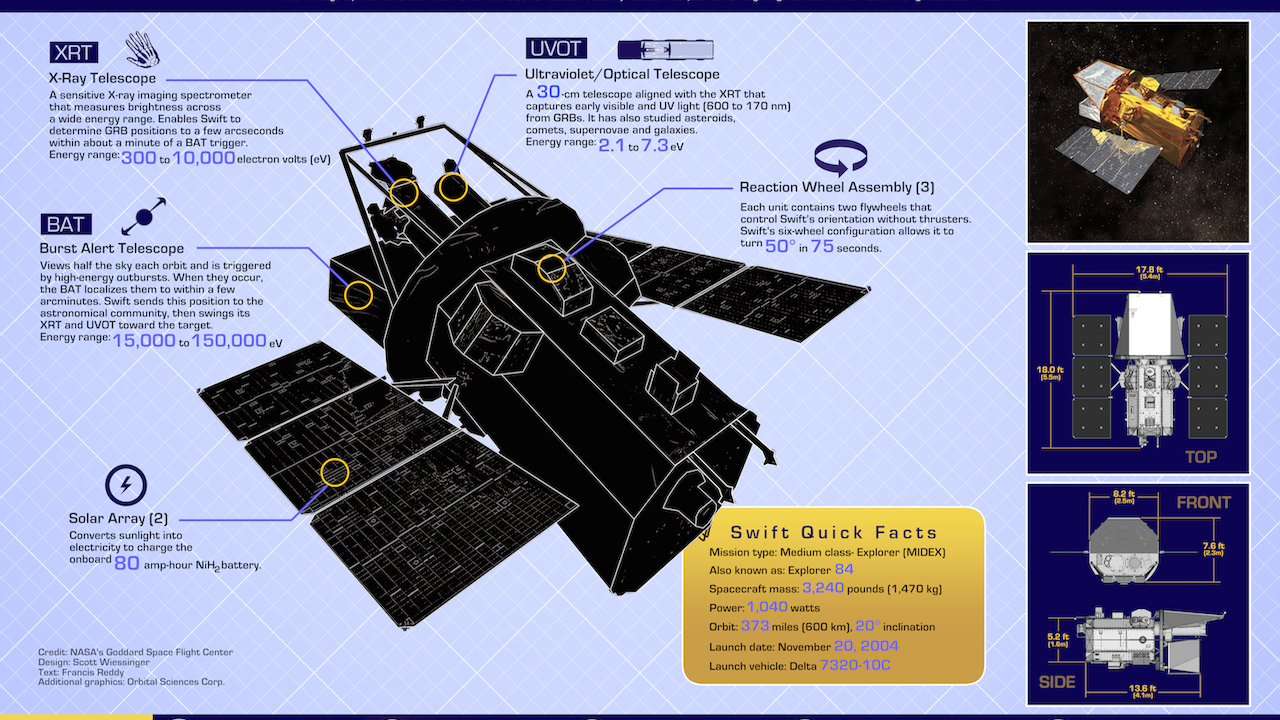Swift: A Decade of Game-Changing Astrophysics
Scientists participating in NASA's Swift mission discuss the spacecraft, the science, and recall their personal experiences as members of the team.
Watch this video on the NASA Goddard YouTube channel.
For complete transcript, click here.
Over the past decade, NASA's Swift Gamma-ray Burst Explorer has proven itself to be one of the most versatile astrophysics missions ever flown. It remains the only satellite capable of precisely locating gamma-ray bursts -- the universe's most powerful explosions -- and monitoring them across a broad range of wavelengths using multiple instruments before they fade from view.
"Swift" isn't just a name -- it's a core capability, a part of the spacecraft's DNA. Gamma-ray bursts (GRBs) typically last less than a minute and Swift detects one event about twice a week. Once Swift observes a GRB, it automatically determines the blast's location, broadcasts the position to the astronomical community, and then turns toward the site to investigate with its own sensitive telescopes.
In addition to its studies of GRBs, Swift conducts a wide array of observations of other astrophysical phenomena. A flexible planning system enables astronomers to request Swift "target-of-opportunity" (TOO) observations, which can be commanded from the ground in as little as 10 minutes, or set up monitoring programs to observe specific sources at time intervals ranging from minutes to months. The system can schedule up to 75 independent targets a day.
Earlier this year, Swift ranked highly in NASA's 2014 Senior Review of Operating Missions and will continue its enormously productive scientific work through at least 2016.
For More Information
Credits
Please give credit for this item to:
NASA's Goddard Space Flight Center
-
Animators
- Chris Meaney (HTSI)
- Scott Wiessinger (USRA)
-
Video editor
- Scott Wiessinger (USRA)
-
Interviewees
- Neil Gehrels (NASA/GSFC)
- Stefan Immler (UMCP)
- Brad Cenko (NASA/GSFC)
- Judith Racusin (NASA/GSFC)
- Alan Wells (U. of Leicester)
- John Nousek (Pennsylvania State University)
- Jamie Kennea (Pennsylvania State University)
- Caryl Gronwall (Pennsylvania State University)
- Patrizia Caraveo (INAF)
- Gianpiero Tagliaferri (INAF)
- Chryssa Kouveliotou (NASA/MSFC)
-
Producer
- Scott Wiessinger (USRA)
-
Videographers
- John Caldwell (Advocates in Manpower Management, Inc.)
- Rob Andreoli (Advocates in Manpower Management, Inc.)
-
Science writer
- Francis Reddy (University of Maryland College Park)
Release date
This page was originally published on Thursday, November 20, 2014.
This page was last updated on Wednesday, May 3, 2023 at 1:50 PM EDT.
Series
This visualization can be found in the following series:Tapes
This visualization originally appeared on the following tapes:-
Swift 10th Anniversary
(ID: 2014067)
Thursday, November 20, 2014 at 5:00AM
Produced by - Robert Crippen (NASA)

